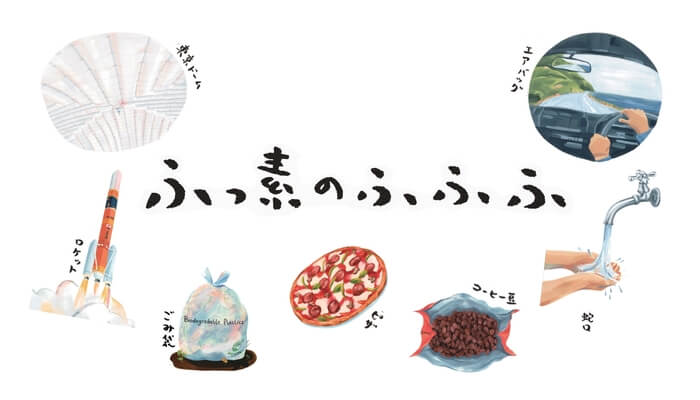About Fluoropolymer (Teflon™)
fluoroplastic is a general term for plastic raw materials that contain fluorine atoms.
There are nine representative resins, including PTFE (polytetrafluoroethylene) and PFA (perfluoroalkoxyalkane).
This plastic has excellent properties including heat resistance, lowest friction, non-stick characteristics, chemical resistance, low friction, and Insulation.
Taking advantage of these characteristics, they are widely used in many industries, including food, chemicals, semiconductors, liquid crystal, scientific equipment, and transportation, supporting modern industry.
fluoroplastic are generally referred to as "Teflon™," but "Teflon™" is actually the product name of fluoroplastic manufactured by Chemours.
What is Teflon™?

Teflon™ is the trade name for the fluoroplastic PTFE raw material manufactured by Chemours.
PTFE, which would later be called Teflon™, was discovered in 1938 by Dr. Plunkett of the American company DuPont.
As part of his research into a new refrigerant, Dr. Plunkett stored tetrafluoroethylene (TFE) gas in a pressure vessel for testing. One day, he opened the lid but no gas came out. He cut the vessel open to examine it and found a white powder on the inside wall. This white powder would later become PTFE. The experiment notes from this time are still kept by DuPont.
During World War II, it was used as a military product, but in 1945 DuPont registered the trademark for PTFE as Teflon™ and began selling it for civilian use in 1946. This made it available for use in many industries, supporting the development of modern industry.
In 2015, Chemours was spun off from DuPont and the Teflon™ trademark was transferred to Chemours.
In addition, in recognition of our more than 50 years of experience in manufacturing fluoroplastic products, in July 2017 we signed a license agreement with Chemours to use the Teflon™ trademark for our fluoroplastic adhesive tape (Chukoh Tape).

Teflon™ is a trademark of The Chemours Company FC, LLC used under license by Chukoh Chemical industries, LTD.
Types and names of Fluororesin
There are nine types of fluororesins, including PTFE and PFA. The table below shows their abbreviations and Japanese names.
| Abbreviation | Name (Japanese name) |
|---|---|
| PTFE | Polytetrafluoroethylene |
| PFA | Perfluoroalkoxyalkane |
| FEP | Perfluoroethylene propene copolymer |
| ETFE | Ethylene-tetrafluoroethylene copolymer |
| PVDF | Polyvinylidene fluoride |
| PCTFE | Polychlorotrifluoroethylene |
| ECTFE | Ethylene-chlorotrifluoroethylene copolymer |
| TFE/PDD | Tetrafluoroethylene-perfluorodioxole copolymer |
| PVF | Polyvinyl fluoride |
The most commonly used resin is PTFE. Most of fluoroplastic commonly known as "Teflon™" is this PTFE.
Characteristics of Fluororesin
There are six main characteristics of fluororesin.
It is
heat resistance, Low temperature resistance, non-stick characteristics, lowest friction, chemical resistance, Insulation and Weatherability.
It is rare for one plastic resin to have so many properties, that fluoroplastic is said to be the "last resort resin."
■ Heat resistance (strength against heat)
The melting point of PTFE is 327℃, and it has superior heat resistance compared to other plastics, with a continuous use temperature of 260℃. Because it does not deteriorate even in high temperature environments, it is required for parts used inside automobiles and in food manufacturing processes.
*Heat resistance varies depending on the processed product. Please check before using the product.
■ Low temperature resistance (resistant to cold)
PTFE has excellent Low temperature resistance down to -253°C, and even when processed into fluoroplastic products, it maintains its high Low temperature resistance allowing it to be used even at -100°C.
*The cold resistance temperature varies depending on the processed product. Please check before using the product.
■ Non-stick characteristics (Resistant to adhering)
Fluoropolymer has the property of not adhering to most substances.
This is also called releasing ability, and even if it does stick, it can be peeled off immediately. Because it does not retain viscous substances, it is used in food manufacturing processes and machine parts such as printing machines. Another advantage is that its non-stick characteristics reduce the cleaning process.
■ Lowest friction
Fluoropolymer has the smallest coefficient of friction of any solid. Because of its low coefficient of friction, it experiences almost no frictional resistance. Its ability to slide is essential in situations where you want to prevent scratches during product transportation or to ensure smooth manufacturing processes.
■ Chemical resistance (strong against chemicals)
Fluoropolymers are not affected by most chemicals or solvents. It is also not susceptible to impurities even when it comes into contact with strong acids or strong alkalis, so it is widely used in semiconductor manufacturing equipment. fluoroplastic products are indispensable for semiconductor manufacturing equipment, including chemical containers, piping, tubes, and wafer carriers.
■ Insulation (does not conduct electricity easily)
fluoroplastic has the highest level of electric insulation among all plastics. It has the smallest dielectric constant and dielectric tangent among all plastics and is not easily affected by frequency or temperature, so it is widely used in high-frequency applications and contributes greatly to our society of high-capacity, high-speed communications.
Furthermore, fluoroplastic circuit board materials and electric wires are highly valued as maintenance-free products, due in part to the heat and Low temperature resistance of fluoroplastic.
■ Weatherability (strong against the outdoors)
Fluoropolymer is hardly affected by ultraviolet rays, visible light, moisture, etc.
Many plastics deteriorate when left outdoors for many years, but fluoroplastic is hardly affected by oxidation caused by oxygen in the atmosphere or chemicals, so it can maintain its strength for over 30 years without deterioration. fluoroplastic also has water repellency, so it is mainly used in the construction industry as roofing and wall materials and sealing materials.
ChukohSky architectural roofing membrane material supplied by our company Suvarnabhumi International Airport (Thailand)
The characteristics of PTFE as viewed from its molecular structure
PTFE, a typical raw material for fluoroplastic, has various characteristics due to its molecular structure. Below are the molecular structures of polyethylene resin (PE) and fluoroplastic (PTFE).
| Formula | Three-dimensional structure | |
|---|---|---|
| Polyethylene (PE) |  |
 |
| fluoroplastic (PTFE) |  |
 |
The molecular structure of PE consists of carbon (C) and hydrogen atoms (H). PTFE consists of carbon (C) and fluorine atoms (F). The CC bonds are the same, but the carbon-hydrogen (CH) and carbon-fluorine (CF) parts are different. When comparing CH bonds with CF bonds, CF bonds have a higher bond energy, so a lot of energy is required to break a CF bond. The fact that more energy is required means that it is less susceptible to deterioration.
Property 1Heat resistance / Weatherability / Chemical resistance
As mentioned above, the high bond energy between carbon and fluorine (CF) means that it is "resistant to degradation unless a large amount of energy is applied." In addition, because fluorine atoms are larger than hydrogen atoms, they are bonded in a slightly twisted state, forming a unique helical structure. Due to this molecular structure, PTFE has the properties of heat resistance, combustion resistance (oxidation resistance), Weatherability, and chemical resistance.
| Bond energy [kJ/mol] | Bond distance (nm) | |
|---|---|---|
| CH bond (CH4) | 412(CH4) | 0.110(CH4) |
| CF bond (in the case of CF4) | 484(CF4) | 0.138(CH3F) |
Property 2non-stick characteristics /water and Oil repellency
PTFE has the characteristic that the polarizability of the CF bond (the ease of electron movement when placed in an electric field) is as small as that of a CH bond. This is due to the strong interaction between the atomic shells of fluorine atoms and electrons, which is a major difference from other halogen atoms. "Low polarizability" = The force acting between molecules is small (small intermolecular forces), so the free energy (surface tension) on the surface comes into play, making it difficult for substances to stick to it. Due to this molecular structure, PTFE has the properties of non-stick characteristics and water- and Oil repellency.
| Material Type | Contact angle with water [degrees] | Adhesion energy [dyn/cm] |
|---|---|---|
| PTFE | 114 | 43.1 |
| Silicone resin | 90 to 110 | 47.8 to 72.7 |
| PE | 88 | 75.2 |
Property 3:Insulation
The C—F bonds in PTFE have a strong bonding force that tightly binds electrons within the molecule, giving PTFE high insulation resistance (volume resistance, surface resistance) and making it difficult for electricity to pass through.
| Volume resistivity (Ω cm) | Surface resistivity (Ω) | |
|---|---|---|
| fluoroplastic (PTFE) | >1018 | >1016 |
| fluoroplastic (PFA) | >1018 | >1016 |
PTFE molding method
PTFE has an extremely high melt viscosity of 1010-12 Pa·sec, so it does not exhibit fluidity even when heated to its melting point of 327°C. (It does not melt into a sludgy mess.) For this reason, it is not suitable for normal molding methods such as the screw extrusion molding method and injection molding method used for general-purpose plastics.
PTFE is broadly divided into three types, each of which is processed using a special molding method that differs from normal molding methods.
■ Molding powder
Molding powder is generally a powder with a size of 100 μm or less.
It is often used in the compression molding method, in which resin is compressed and hardened and then baked, to create PTFE blocks such as plates and monolithic vessels.
In addition, it is also possible to produce film by compressing resin into a cylinder and cutting it from the outside.
■ Fine Powder
Fine powder is granular, but when pressure is applied it breaks down into fibers.
Therefore, it is used in the paste extrusion molding method, where it is mixed with a solvent and extruded. Tubes and sealing tapes are molded using this method.
■ Dispersion
The dispersion is an aqueous dispersion that has been emulsion-polymerized and stabilized with a surfactant.
It is used in the impregnation coating method where cloth etc. is dipped in the dispersion. It is often baked after drying. At our company, it is used in fabric products and architectural roofing membrane material ChukohSKY™, where glass cloth is impregnated with PTFE.
| Resin Type | Processing method | Affected Products |
|---|---|---|
| Molding Powder (Powder form derived from suspension polymerization method) |
Compression molding method / Ram extrusion molding method | |
| Fine Powder (Granular form derived from emulsion polymerization method) |
Paste extrusion method / Roll molding method | |
| Dispersion (emulsion liquid derived from emulsion polymerization method) |
Impregnation Coating Method |
Molding methods for fluoroplastic other than PTFE
fluoroplastic other than PTFE, such as PFA and ETFE, have a melt viscosity of approximately 103-4 Pa·sec, so they can be molded using the same molding techniques as general thermoplastic resins. However, because molten fluoroplastic corrodes metals that it comes into contact with, it is necessary to use corrosion resistance-resistant metal materials.
We also manufacture PFA tubes and PFA Injection molding products.
We have launched the "Fluorine Fufufu" advertising series to help you become more familiar with fluoroplastic. It's full of "fufufu" information about fluoroplastic that you'll want to tell someone about. Please take a look!
【reference】
・ Japan Fluoroplastics Industry Association fluoroplastic Handbook
・Q&A about fluoroplastic
































